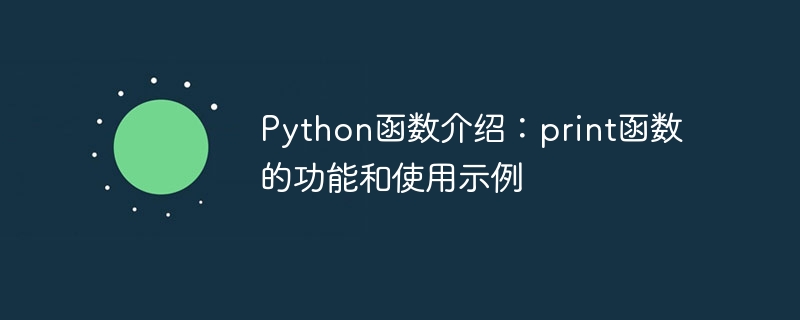

Python is a popular programming language designed to make computer programming simpler and easier to understand. In Python, using the print function to output text to the console is a basic task. In this article, we'll introduce Python's print function, explore its capabilities and usage examples, and provide code examples to help you better understand how to use the function.
Python's print function is a built-in function used to output text and variable values. Its syntax is very simple. You just put the text or variable name you want to output inside the print function and press the "Enter" key. For example, you can use the following code to output "Hello, world!":
print("Hello, world!")
This will output the text "Hello, world!" on the console.
However, the print function can not only output simple text. Here are some common uses of the print function:
To view the value of a variable, use the name of the variable in the print function and replace It is enclosed in quotation marks. For example:
x = 5 print("The value of x is:", x)
This will output the text "The value of x is: 5".
To output the values of multiple variables, just list them in parentheses in the print function. For example:
x = 5 y = 10 print("The values of x and y are:", x, y)
This will output the text "The values of x and y are: 5 10".
If you need to output the variable value together with some text, you can use string formatting. In Python, you can use placeholders to specify where a variable should appear. For example, the following code can insert the values of the variables x and y into the output statement:
x = 5 y = 10 print("The values of x and y are: %d and %d" % (x, y))
This will output the text "The values of x and y are: 5 and 10".
You can use other parameters of the print function to control the way of output. For example, use the end parameter to set the delimiter used in output. By default, spaces are used as delimiters. For example:
print("one", "two", "three", end="|")
This will output the text "one two three|".
Finally, you can also redirect the output of the print function to a file. This can be done by passing the filename as an argument to the print function. For example, the following code saves the output to a file:
with open("output.txt", "w") as f: print("Hello, world!", file=f)
This will create a new line in a file named "output.txt" and write "Hello, world!" to the file.
To sum up, the print function is one of the most basic and commonly used functions in Python. It can be used to output simple text or the value of a variable. By using formatting and other parameters, you can control how the output is output and redirect the output to a file. Hope this article can help you better understand the usage and function of print function in Python.
The above is the detailed content of Introduction to Python functions: functions and usage examples of the print function. For more information, please follow other related articles on the PHP Chinese website!




